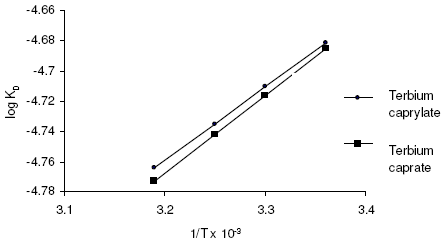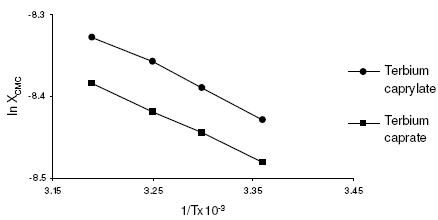Serviços Personalizados
Journal
Artigo
Indicadores
-
 Citado por SciELO
Citado por SciELO -
 Acessos
Acessos
Links relacionados
-
 Similares em
SciELO
Similares em
SciELO
Compartilhar
Portugaliae Electrochimica Acta
versão impressa ISSN 0872-1904
Port. Electrochim. Acta v.28 n.4 Coimbra 2010
Investigation Into the Conductance, Micellization and Dissociation Behaviour of Terbium Caprylate and Caprate in 60/40 Benzene-methanol Mixture (v/v)
Kamal Kishore,* S. K. Upadhyaya
P.G. Department of Chemistry, S.S.L. Jain College, VIDISHA-464001, INDIA
DOI: 10.4152/pea.201004213
Abstract
Conductance measurements were employed to determine the critical micellar concentration, CMC, limiting molar conductance at infinite dilution, degree of dissociation and dissociation constant of terbium caprylate and caprate in 60/40 benzene-methanol (v/v). The results have shown that these soaps behave as a weak electrolyte in dilute solutions and Debye-Hückel-Onsager’s equation is not applicable to these soap solutions. The thermodynamic parameters indicate that the micellization process is favoured over the dissociation process.
Keywords: heat of dissociation, critical micellar concentration, micellization, free energy.
Introduction
A wide variety of metal soaps find important applications in a number of industries. Their appreciable solubility in organic solvents and availability at a reasonable cost make them potentially useful as water proofing, catalysts, greases, lubricants, driers and in cosmetics. Metal soap with elements of lanthanide series were synthesised for the first time by Mishra et al. [1]. Mehrotra et al. [2-5] investigated acoustical and thermodynamic properties of lanthanide soaps and concluded that these soaps behave as weak electrolyte in dilute solutions. Upadhyaya et al. studied thermodynamic [6,7] and ultrasonic [8] behaviour of metallic soaps. They inferred that there is a significant interaction between soap-solvent molecules in dilute solution and soap molecules do not aggregate appreciably below the CMC. Topallar et al. [9] investigated the conductance behaviour of chromium soaps in different solvents. The comparative study on micellization and electrolytic behaviour of dysprosium soaps in methanol were carried out by Shukla et al. [10]. However studies on terbium soaps in benzene-methanol mixture have not yet been undertaken systematically.
The present manuscript deals with the study of conductance of solutions of terbium caprylate and caprate in a mixture of 60/40 benzene-methanol (v/v) at different temperatures. The results have been used to find out the nature of these soaps in non-aqueous medium and to determine various thermodynamic parameters.
Experimental
Anala R grade caprylic acid, capric acid, benzene, methanol, acetone and terbium acetate (purity 99.9% received from Indian Rare Earth Limited, Kerala) were used for the present investigation. The terbium caprylate and caprate were prepared by direct metathesis of corresponding potassium soaps (caprylate and caprate) by pouring a slight stoichiometric excess of aqueous terbium acetate solution into clear potassium caprylate and caprate dispersion at raised temperature with vigorous stirring. The precipitates were filtered off and washed with hot distilled water and acetone. After initial drying in an air oven 50-60 ºC, final drying was carried out under reduced pressure. The purity of soap was checked by the elemental analysis and results were found in agreement with theoretically calculated values. In general chemical reactions for the synthesis of these soaps are as follows:

where R is C7H15, C9H19 for caprylate and caprate, respectively.
Solutions of terbium soaps were prepared by dissolving a known amount of soap in a mixture of 60/40 benzene-methanol (v/v) and kept for 2 hrs in a thermostat at desired temperature. The conductance of solutions was measured with a “Systronics conductivity Bridge 305”(S R No. 993) and a dipped type conductivity cell with platinised electrode at 25º, 30º, 35º, 40 ºC. The cell constant (1.0) was measured by using standard solution of potassium chloride. The specific conductance and molar conductance are expressed in mhos cm-1 and mhos cm-1 (g mole)-1 l, respectively.
Results and discussion
Specific conductance, k, of the solutions of terbium caprylate and caprate in a mixture of 60/40 benzene-methanol mixture (v/v) increases with an increase in soap concentration, C, temperature and decrease in chain-length of the soaps (Fig. 1). The increase in the specific conductance with soap concentration may have been due to dissociation of these soaps in mixed organic solvent, in dilute solutions. However, an increase in specific conductance at higher soap concentration is probably due to the formation of ionic micelles.

Figure 1. Specific conductance vs. soap concentration of terbium caprylate in a mixture of 60/40 benzene-methanol (v/v) at various temperatures.
The decrease in specific conductance with increasing the number of carbon atoms in the fatty acid chain of the soap molecules may have been due to the higher molecular weight and decreasing mobility of anions. The plots of specific conductance, k, vs. soap concentration, C, (Fig. 1) are characterised by a break, corresponding to CMC (Table 1), which indicates that the micelle formation takes place at a definite soap concentration.
Table 1. Critical micellar concentration, CMC (g mole l-1) of terbium caprylate and caprate in a mixture of 60/40 benzene-methanol (v/v) at various temperatures.

Molar conductance, µ, of terbium soaps (caprylate and caprate) solutions in 60/40 benzene-methanol mixture (v/v) decreases with increasing concentration and chain-length of the soaps. The critical micellar concentration, CMC, cannot be, however obtained from the plots of molar conductance vs. square root of soap concentration, which are concave upwards with increasing slopes indicating that soaps behave as weak electrolyte in dilute solutions. The decrease in molar conductance is attributed to the combined effects of ionic atmosphere, solvation of ions and decrease in mobility and ionisation with the formation of micelles.
The Debye-Hückel-Onsager’s equation [11] is not applicable to these soaps solutions. Molar conductance results indicate that terbium caprylate and caprate behave as weak electrolytes in dilute solutions; the following expression [12] for their dissociation can be derived:

The dissociation constant, KD and limiting molar conductance, µ0 (Table 2) have been obtained from the slope,  and the intercept,
and the intercept,  of the linear plots of µ2C2 vs. 1/µ for dilute soap solutions.
of the linear plots of µ2C2 vs. 1/µ for dilute soap solutions.
Table 2. Molar conductance at infinite dilution, µ0 and dissociation constant, KD of terbium caprylate and caprate in a mixture of 60/40 benzene-methanol (v/v) at various temperatures.

It is observed that an increase in temperature brings about an increase in the limiting conductance at infinite dilution, µ0 and decrease in their dissociation constant, KD (Table 2). The decrease in the value of dissociation constant with increasing temperature indicates the exothermic nature of the dissociation of these terbium soaps in a mixture of 60/40 benzene-methanol. The degree of dissociation, α, at various soap concentrations can be measured by using it to be equal to the conductance ratio, µ/µ0.
The heat of dissociation, ΔHD, for terbium caprylate and caprate is determined by using following equation:

The values of heat of dissociation, ΔHD, were obtained from the slope of the linear plots of log KD vs. 1/T (Fig. 2) and mentioned in Table 3. Since the values of heat of dissociation, ΔHD, are negative, indicates that the dissociation process for terbium soaps (caprylate and caprate) is exothermic in nature.

Figure 2. log KD vs. 1/T for terbium caprylate and caprate.
Table 3. Heat of dissociation, ΔHD and heat of micellization, ΔHM of terbium caprylate and caprate in a mixture of 60/40 benzene-methanol (v/v) at various temperatures.

The values of change in free energy, ΔGD, and standard entropy change, TΔSD for the dissociation process are calculated by using the relations:

The calculated values of ΔGD and TΔSD are recorded in Table 4.
Table 4. Thermodynamic parameters of the dissociation of terbium caprylate and caprate in a mixture of 60/40 benzene-methanol (v/v) at various temperatures.

In case of micellization, i.e., aggregation process, when counter-ions are bound to a micelle, the standard free energy change of micellization, ΔGM for phase separation model [13-15] is given by

where XCMC is the CMC expressed as a mole fraction and is defined as,

Since the numbers of moles of free soap, ns, are small as compared to the number of moles of solvent, n0.
The standard enthalpy change of micellization, ΔHM, for phase separation model is evaluated as follows:

The values of ΔHM have been determined from the slope of linear plots of ln XCMC vs. 1/T (Fig. 3) and mentioned in Table 3. The positive enthalpy for micellization, ΔHM, indicates that the association of terbium caprylate and caprate in 60/40 benzene-methanol (v/v) is endothermic.

Figure 3. ln XCMC vs. 1/T for terbium caprylate and caprate.
The standard entropy change for micellization is calculated as,

The micellization of the soaps (Table 3 and 5) in a mixture of 60/40 benzene-methanol (v/v) is consistent with ΔHM > 0, ΔGM < 0, TΔSM > 0. However, dissociation of these soaps is consistent with ΔHD < 0, ΔGD > 0, TΔSD < 0.
Table 5. Thermodynamic parameters of the association of terbium caprylate and caprate in a mixture of 60/40 benzene-methanol (v/v) at various temperatures.

The negative value of free energy of micellization, ΔGM, positive value of ΔSM for micellization and positive value of ΔGD and negative value of ΔSD for the dissociation indicate that micellization process is favoured over the dissociation process. It may, therefore, be inferred that in a mixture of 60/40 benzene-methanol (v/v) terbium caprylate and caprate behave as weak electrolytes. Thermodynamic parameters for association and dissociation are found to be in good agreement with other literature data [16]. The values of the critical micellar concentration increase with increasing temperature and the micellization process is predominating over dissociation process.
References
1. S.N. Mishra, T.N. Mishra and R.C. Mehrotra, J. Inorg. Nucl. Chem. 25 (1963) 195. [10.1016/0022-1902(63)80009-3] [ Links ]
2. K.N. Mehrotra, A.S. Gahlaut and M. Sharma, J. Colloid and Interface Sci. 120(1) (1987) 110. [10.1016/0021-9797(87)90328-6]
3. K.N. Mehrotra, M. Chauchan and R.K. Shukla, Phys. Chem. Liq. 18 (1988) 295. [10.1080/00319108808078605]
4. K.N. Mehrotra and S.K. Upadhyaya, J. Am. Oil Chemists Soc. 67(7) (1990) 464.
5. K.N. Mehrotra and S.K. Upadhyaya, Polish. J. Chem. 654 (1991) 1035.
6. S.K. Upadhyaya and P.S. Sharma, Ind. J. Chem. 34(A) (1995) 220.
7. S.K. Upadhyaya and C. Singh, Asian J. Chem. 18(1) (2006) 129.
8. K. Kishore, S.K. Upadhyaya and Y. Walia, Int. J. Theo. App. Sci. 1(1) (2009) 32.
9. H. Topallar and Y. Bayrak, Tr. J. Chem. 22 (1998) 167.
10. R.K. Shukla, S.K. Upadhyay, M. Shukla, M. Gupta and G. Sharma, J. Ind. Chem. Soc. 86 (2009) 171.
11. I.N. Levine, Physical Chemistry, Fourth Edition, McGraw Hill Inc., p.485 (1995).
12. C.A. Kraus and W.C. Bray, J. Am. Chem. Soc. 35 (1913) 1315. [10.1021/ja02199a001]
13. B.W. Barry and G.F. Russel, J. Colloid Interface Sci. 40 (2) (1972) 174. [10.1016/0021-9797(72)90007-0]
14. D.C. Robins and I.L. Thomas, J. Colloid Interface Sci. 26 (4) (1968) 407. [10.1016/0021-9797(68)90287-7]
15. D. Attwood and A.T. Florence, Surfactant systems, London-New York, p.100 (1983).
16. K. Kishore and S.K. Upadhyaya, Tenside Surf. Det. 47(3) (2010) 184.
Received 22 September 2009; accepted 31 August 2010
* Corresponding author: k_81kishore@yahoo.co.in














